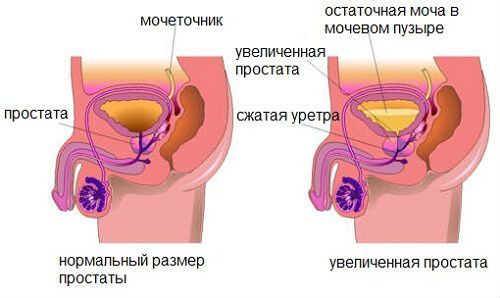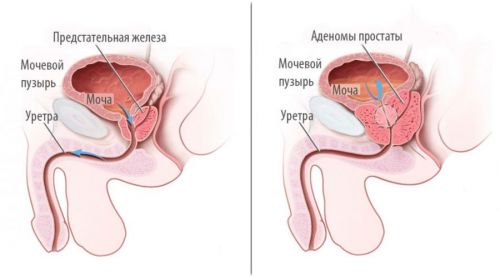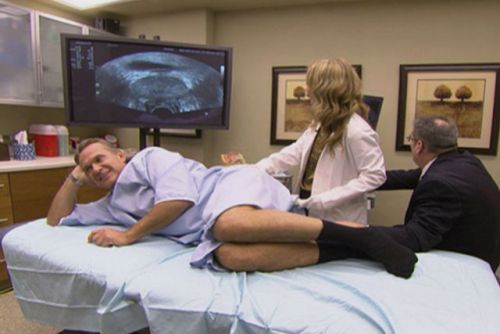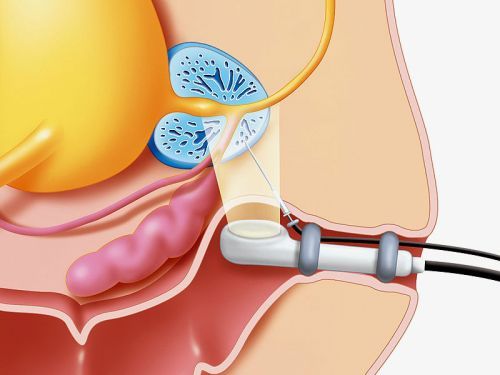The first signs of BPH in males of these groups can occur up to 40 years. Because in this age there are often violations of sexual possibilities, for many patients, the identification of the adenoma as the cause of weakening of potency, it becomes unexpected news.
The course and clinical manifestations of BPH depend on the direction and rate of growth, the size of the adenoma.
The symptoms of BPH appear at the age of 45 years or older. If among the forty men of them feels, every tenth, then in old age they have 80%.
Who often suffers from adenoma?
The disease often develops early:
- in people of mental labor, long sitting behind a Desk;
- slothful and inactive;
- of drivers;
- prefer spicy meats and alcohol;
- having extra weight.
The prostate produces up to 1/3 of the total volume of the ejaculate, involved in the preservation of sperm motility in the process of release of sperm. A significant role in prostate retention of urine and smooth urination.

Gland surrounds the upper part of the urethra. Any increase in swelling, inflammation or due to hyperplasia nodes causes mechanical compression of the urethra with subsequent symptoms of benign prostatic hyperplasia associated with impaired urine flow.

The accumulation of residual urine in the bladder due to the delay of her release
How quickly do symptoms develop?
The symptoms of BPH in men manifest only when the size of the prostate poses a serious obstacle to the outflow of urine. The disease is characterized by slow development. Some patients have no signs of diagnosis is not occurring despite the increased size of the prostate. This is possible if the growth direction is in the direction of the rectum.
Conversely, if the increase in the average share of the prostate towards the bladder even small amounts cause a pronounced pressure on the opening of the urethra difficult urination and may even result in acute urinary retention. Although to palpate the node through the rectum fails.
Initial symptoms of intermittent. They are worse after drinking, the stress, colds, and then weaken. The diagnosis of BPH. Because the symptoms of voiding it is not specific, can accompany cancer.
The development of prostate hyperplasia goes through three stages. Consider what characteristic features can detect male in each stage and how they change over time as breast augmentation.
What happens in the first stage?
The initial stage of the disease may occur unnoticed. It is called the “phase precursors”. Difficulties with urination are fickle, often associated with the ingestion of alcohol, spicy food, flu.
The bladder is emptied completely. His muscle (the detrusor) is forced to work hard, trying to push the flow of urine in soienoe hole channel. Changes of a functional nature in the overlying organs of the urinary output occurs.

Men notice the symptoms:
- urination not so free as before;
- the intensity of the blast reduced;
- more often have to get up to pee at night.
Sleep interrupted in the morning hard to get ready for work
This is not serious person, often associated with age or a strenuous day of work. Moreover, in day time, almost all passes. Upon careful questioning of the patient can reveal this feature, as anticipation of urination. Urine comes out immediately, but after some time.
Then the man pays attention:
- for small amounts of urine;
- frequent trips to the bathroom and by day;
- sheer sluggish stream of urine;
- a strong uncontrollable urges.
These symptoms compel the patients to adapt and difficult life situations. You have to naturopathica, which causes additional load on the muscles of the pelvic floor, the diaphragm. Hidden or latent stage lasts for many years depending on the compensatory forces the muscles of the bladder. The patient’s condition remains stable. The main feature – the absence of residual urine and emptying your bladder when urinating.
What distinguishes the second stage of the disease?
The next stage is characterized by a loss of body reserves to compensate the excretion of urine. The bladder is not fully emptied (there is about 200 ml of urine). In the detrusor dystrophic changes appear. Muscle flabby, lose tone. The cavity expands.
Signs of benign prostatic hyperplasia in this stage:
- the act of urination is divided into time periods, a man has much to naturopathica, expect the next portion of urine;
- the patient notes the need for rest when urination;
- we have a long time to be in the toilet.
From the constant natureline men might have rectal prolapse the formation of hernias of the abdominal wall.
A forced increase in the pressure in the bladder compresses the ureters overstretched mouth of bundles of muscle fibers. Violation of the transport of urine is passed into the renal pelvis. They stretch and compress the renal parenchyma. Begins impaired renal function.

Depending on the previous state of the man may be signs of non-permanent kidney failure:
- polyuria;
- dry mouth;
- thirst;
- a sense of bitterness and bad breath.
Added signs of inflammation of the urinary tract. Condition of the mucous membranes are very vulnerable to pathological flora. Stagnant urine is a good environment for breeding.
The mechanism of the reverse cast into the pelvis not only causes cystitis, urethritis, and pyelonephritis
Complicating dietary factors, stress can cause acute urinary retention. The patient was taken to the hospital, where I try to remove the urine catheter. After the procedure, men experience relief for some time recovering urination. But then again we have to ask for help.
Stage of decompensation
The third stage represents the mechanism of failure of compensatory adaptations. Disrupts the function of the bladder as to ensure the storage and collection of urine and excretion. Failure is observed overlying the urinary organs with the formation of chronic renal failure.
The detrusor muscle completely loses the ability to contract. The bladder is distended, residual urine. He stands above the pubis, and is determined by palpation of the abdomen. This diagnostic test ultrasound upper contours are fixed at the level of the navel.
Men appear:
- constant desire to urinate;
- pain in prostate cancer continuous, localized in the lower abdomen;
- urine drops;
- occurs incontinence, leakage without volitional participation.
Typical “paradoxical latency”:
- on the one hand the bladder is full;
- on the other – urine drip out on their own.
Seriously disrupted the work of the kidneys in connection with compression of the structures of cortex and medulla.
Patients appear:
- weakness;
- lack of appetite;
- thirst and dry mouth;
- constipation;
- nausea, vomiting;
- hoarse voice;
- the smell of urine out of his mouth.
Growing changes in the psyche. They are:
- anxiety,
- apathy to the environment,
- increased anxiety.
The changes in psychoemotional sphere are observed in almost all patients men
In the absence of treatment in the patient’s blood increases rapidly, the level of nitrogenous substances appear and electrolyte changes. The patient may die from uremia.
Symptoms of complications
Complications in the course of the disease may occur at any stage. No one is immune. The development of infection in the urinary tract causes inflammatory diseases urethritis, cystitis, pyelonephritis.
Their main manifestations are:
- pain in the lumbar region, the abdomen;
- temperature rise;
- burning sensation and cramps when urinating;
- frequent urination with incontinence;
- unpleasant smell of urine and bedding;
- hypertension;
- shortness of breath;
- cramps in the muscles of the legs.
Kidney stone disease is manifested by unilateral attacks of renal colic. The man feels a sudden sharp pain in abdomen radiating to groin, genitals, lower back. In the background, and after an attack appears hematuria.
With acute urinary retention long-term patient incapable of independent emptying of the bladder.
Symptoms of the condition:
- strong constant urge to urinate;
- pain in the prostate adenoma localized in the suprapubic region, radiating around the abdomen, in the lower back;
- inability straining to allocate even a little urine.
The lack of timely medical care is threatening kidney damage, acute failure.
Hydronephrosis – overflow condition of the renal pelvis with stretching of the capsule and increase in the size of the body. Occurs when the acute delayed and chronic accumulation of residual urine.
Dysuric in addition, the patient has these symptoms:
- nausea;
- vomiting;
- arching lower back pain and in the abdomen;
- fever.
Why do I need a survey?
These symptoms characterize the condition of the entire urinary system. They show that prostatic hyperplasia can have a very negative impact, because it provokes a dysfunction of the renal apparatus.
Therefore, timely diagnosis of benign prostatic hyperplasia is necessary when the first symptoms.

For this purpose:
- Finger examination of the prostate, is a medical assistant in a medical office clinic, allows to detect the increase in volume, consistency of the authority to refer the patient to a urologist.
- Cystoscopy – visual examination of the bladder cavity to identify signs of inflammation, tumors.
- The doctor is required to appoint General clinical blood tests, urine tests, if necessary tests on biochemistry. They help to identify inflammation, the initial symptoms of renal failure, tendency to form stones.
- Uroflowmetry – method study of the process of urination, it is possible to make a conclusion about the presence or absence of compensatory bladder capacity.
- The ultrasonic method of diagnostics is used with rectal probe, inserted into the rectum examination (TRUS – transrectal).
Method TRUS is essential for detection of tumor volume, growth areas and the nature of the nodes
All patients doctors recommend to undergo a blood test for PSA. This is a special reaction based on the detection of antibodies to cancer cells. Used for differential diagnosis and detection of prostate cancer.
Men should not hope for a long and oligosymptomatic the course of benign prostatic hyperplasia. Supervision of a urologist allows to timely detect a progressive growth, apply conservative treatment.



